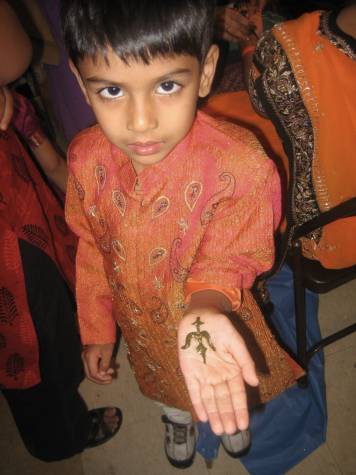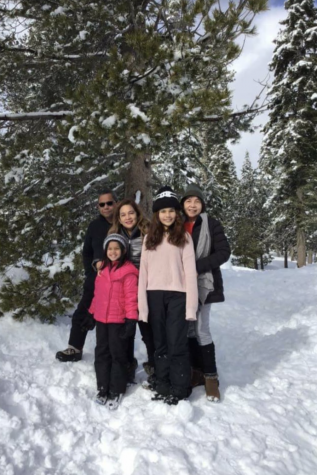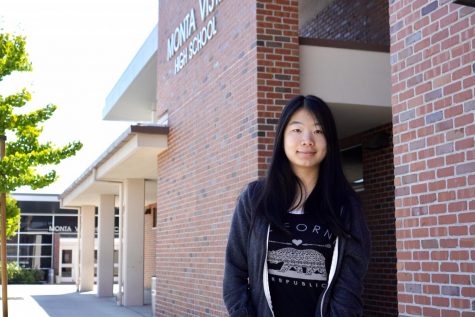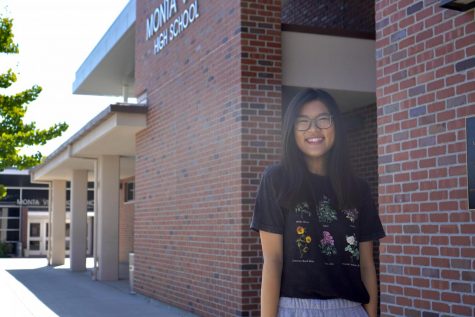A twist on tradition
Sharing the different ways that MVHS students celebrate winter holidays
December 17, 2020
ASHWIN DESAI

Bingo!
It’s an annual tradition to play the game at the neighborhood Diwali party, where every family pitches in $10 and gets a Bingo card. There are a few winners each time, but senior Ashwin Desai’s family has won so many times that the neighbors jokingly say, “OK, of course they’re going to win this year.”
Diwali is the festival of light celebrated by Hindus, Jains and Sikhs to recognize the joy in life and the world while protecting from evil by scaring away the darkness. The holiday features gatherings with friends and family, assembling lights and setting off sparklers and fireworks.
According to Desai, the act of celebrating Diwali with family is an important aspect, but since Desai’s extended family does not live in the U.S., his immediate family celebrates with friends instead. This year’s party was entirely canceled due to COVID-19.
“We cater a lot of food and everyone doesn’t eat until lunchtime, where they just eat a lot of food and it’s a lot of different varieties of food,” Desai said. “So [it’s] really fun to just chow down and have fun with your friends.”
Celebrations from other years involved many neighbors, including those who are not ethnically Indian.
“Diwali, for my family and families in my neighborhood, we really just want to celebrate with as many people as we can and bring as much joy and happiness and have a good time,” Desai said. “So if there’s anybody in our neighborhood who’s even a little interested in [celebrating] Diwali, … we just [invite] them over. They [don’t] have to be Indian all, but we just want to get as many people as possible to celebrate with us.”
When Desai moved to the Cupertino area in 2009, he began joining in the neighborhood celebrations — there were already non-Indians who attended the festivities. As Desai entered middle school, he began inviting his own friends to the party as well, regardless of their ethnicity, where they ate food and set off fireworks together.
A funny moment Desai remembers was during a seventh-grade celebration, when he waved sparklers around in an infinity pattern — a few of the sparks flew off onto his kurta, a traditional Indian piece of clothing, causing a small flame. He extinguished it by patting it, but it left a hole in his clothing.
Due to COVID-19, Desai’s family limited their celebrations this year by celebrating later than the actual date of Diwali as they waited for his brother to return home.
“This year, since all the stuff that’s going around in the world, no one in my family feels like they really want to celebrate,” Desai said. “It feels like, ‘OK, we can just set up lights and have a mini dinner, but that’s about it.’ It’s not usually as grand as we’d normally have it to be.”
DANIEL KAO

As holiday music plays in the kitchen, senior Daniel Kao tenderizes and seasons meat for Thanksgiving dinner — his sisters don’t particularly enjoy touching raw meat, so the job falls to him. Starting from when Kao’s sister was in middle school taking the cooking elective, Kao and his two older sisters have cooked holiday meals for the family. Although they enjoy cooking, they’re usually quite busy and don’t often get to cook for the whole family, so this is a special occasion.
In the past, the Kao siblings have made traditional Western food like turkey, and they’ve also explored Asian foods like hotpot. For these past two years, they wanted to try something new: making gumbo, a Cajun dish, last year and paella, a Spanish dish, this year.
“This time, we just felt like paella was the way to go because it’s a very festive food,” Kao said. “It’s a big plate, everybody comes and takes a little bit, type of thing.”
For the past few years, the dishes have been Kao’s idea. He likes looking for bold flavors, inspired by the cooking videos he watches during his free time.
“Sometimes it’s easier to follow recipes if you’re watching a video [when] trying to make something like pasta,” Kao said. “There’s plenty of YouTube videos out there, like Bon Appetit does great ones [and] so does Epicurious.”
Kao also enjoys experimenting with different cuisines, especially Asian food, as he tries to incorporate more dashi, a Japanese soup stock, and gochujang, a Korean red chili paste. YouTube also serves as inspiration with trying new dishes, which has proven to be a struggle due to the ambiguity around online Asian recipes.
“For Asian food, it’s different because Asian recipes tend to not really exist, it’s more like you’re just following what your heart tells you to do,” Kao said. “So for those, [there’s] a lot of cooking shows on YouTube where people are just showing you how to do it, and sometimes they have measurements, sometimes they don’t. It just gives you an idea of how to make the dish.”
As Kao learned to cook, he and his sisters have tackled more extravagant dishes. In sixth grade, they made a mint-themed Thanksgiving feast, where all the foods had mint, including pasta, chowder and salad. As they’re usually making four to five dishes, preparing the food usually takes about five hours. Kao enjoys the time with his siblings, joking around and listening to music with them, as well as cooking in general.
“I’ve always liked cooking,” Kao said. “It’s just something that’s therapeutic in a way, like you don’t have to think too much about it — just do it. So [it] just gets you into the holiday mood.”
MARIAN MONTEJANO-CASTO

For most, the Christmas season begins, at its earliest, in November, and families open gifts on Christmas morning. For sophomore Marian Montejano-Casto’s family, however, the holiday season looks a little different.
Montejano-Casto’s family starts celebrating Christmas in September, from listening to Christmas music to decorating the household. Among one of the Christmas decorations is the parol, which is a traditional Filipino ornamental lantern.
“[The parol is] a guide for the three kings to give Jesus presents, and we put those in front of our houses, near our doorway, to indicate that Jesus should receive his presents from the three kings. They are lanterns, so they light up each night,” Montejano-Castro said.
Montejano-Casto’s family also partakes in a popular Filipino Christmas tradition called Simbang Gabi, meaning “Mass at Night,” which consists of a novena — nine straight days of Mass — starting on Dec. 16.
“You go to church at nighttime, usually midnight,” Montejano-Castro said. “And then after Mass, there would be some food out for the people and you would eat with your friends and your family. [On] Dec. 16, you would make a wish, and then if you attend all nine [days of the Simbang Gabi], you would get a Christmas wish guaranteed. So on Christmas Eve, you would get your wish guaranteed.”
After the last midnight mass of Simbang Gabi, Montejano-Castro’s family would then have a nighttime dinner called Noche Buena. While similar to a traditional Christmas dinner, the Noche Buena menu consists of many traditional Filipino foods, such as noodles and rice cakes.
Montejano-Casto also emphasizes the importance of family gathering during the holiday season, as Christmas is the only celebration when she gets to see everyone at the table. In the past, her extended family would usually fly out from Texas to Lake Tahoe to celebrate all together, a decision made because they wanted a Christmas with snow.
This year, Montejano-Castro’s extended family isn’t flying out to join them because of the pandemic, but they are still trying to make the holiday season as normal as possible by continuing to practice certain traditions, such as starting celebrations during September and video calling family members.














